Increasing the pace of new innovations and constantly releasing new products with small incremental changes is sometimes a strategy for firms in highly competitive markets, to secure their market shares. This problem, together with the impossibility for households (or the economic inaccessibility) to repair broken products is meant to be a symptom of planned obsolescence. With this term it is considered that mechanism used by firms to increase sales by making product less durable, forcing people to change them more often.
The recent trends in legislation, are going in the direction of giving the “right to repair” to consumers, avoiding them the frustration of buying a new appliance after the warranty runs out. To have an idea of the dimension of the problem, the proportion of major household appliances that died within the first five years rose from 3.5% to 8.3 %( between 2004 and 2012). Moreover, other studies say that at recycling centres averagely more than 10% of the junked washing machines are less than five years old.
EU new approved standard, refers to lighting, televisions and large home appliances. Manufacturers will have to supply key parts for up to 10 years making them available to independent professionals. Activists are protesting as the EU Commission has allowed manufacturers to keep the repair process for professionals under their control. Their requested possibility for consumers to have the “right to repair” by themselves finds the strong opposition of firms, that raise questions about risk and liability.
Repairing and restoring products to a usable condition, would guarantee longer lasting products would have an impact reducing waste and emissions associated to the product lifecycle.
Currently not many companies are investing in strategies that aim at closing the loop of the supply chain, mainly for the lack of economic convenience. This is due to the fact that prices do not take into account for the negative externalities. According to the principle of the Circular Economy, other strategies could be used furtherly reduce the waste generated in the white goods industry, like remanufacturing and products as a service.
References
https://www.bbc.co.uk/news/business-49884827?fbclid=IwAR3gfmC8AGLtmOlnpPGrJbA32FTgZuV5RU3IDWhAaBMZq5b9mX5rY2aZuEc
https://www.bbc.co.uk/news/science-environment-46797396
A. Genovese, M. Pansera, The Circular Economy at a crossroad: Technocratic Eco-Modernism or Convivial Technology for Social Revolution?

